
|
py_trees_ros_viewer package from py_trees_ros_viewer repopy_trees_ros_viewer |
|
|
Package Summary
| Tags | No category tags. |
| Version | 0.2.5 |
| License | BSD |
| Build type | AMENT_PYTHON |
| Use | RECOMMENDED |
Repository Summary
| Checkout URI | https://github.com/splintered-reality/py_trees_ros_viewer.git |
| VCS Type | git |
| VCS Version | devel |
| Last Updated | 2025-01-14 |
| Dev Status | MAINTAINED |
| CI status | No Continuous Integration |
| Released | RELEASED |
| Tags | No category tags. |
| Contributing |
Help Wanted (0)
Good First Issues (0) Pull Requests to Review (0) |
Package Description
Additional Links
Maintainers
- Daniel Stonier
- Sebastian Castro
Authors
- Daniel Stonier
PyTrees ROS Viewer
[About] [Features] [Quickstart] [Usage] [Modding]
About
A Qt-JS application for visualisation of behaviour trees in a ROS 2 ecosystem. This implementation serves as the GUI visualisation tool for PyTrees ROS.
Features
- Tree Visualisation
- Collapsible Subtrees
- Zoom and Scale Contents to Fit
- Timeline Rewind & Resume
- Blackboard View
- Activity View
Quickstart
sudo apt install ros-<rosdistro>-py-trees-ros-tutorials
sudo apt install ros-<rosdistro>-py-trees-ros-viewer
# In a first shell
py-trees-tree-viewer
# In a second shell
ros2 launch py_trees_ros_tutorials tutorial_eight_dynamic_application_laoding_launch.py
# Click 'Scan' on the qt robot dashboard interface
# Wear a colander, I am too.
Usage
Until a snapshot stream is discovered or selected, you’ll land at the splash screen which enumerates the interactive options available.

The viewer will continuously scan for and update the namespace drop-down with a list of py_tree instances (specifically, the namespace of their snapshot stream services). If not yet connected, it will provide the convenience of automatically making a connection to the first instance it discovers. Beyond that, it is possible to switch between streaming services via the drop-down.
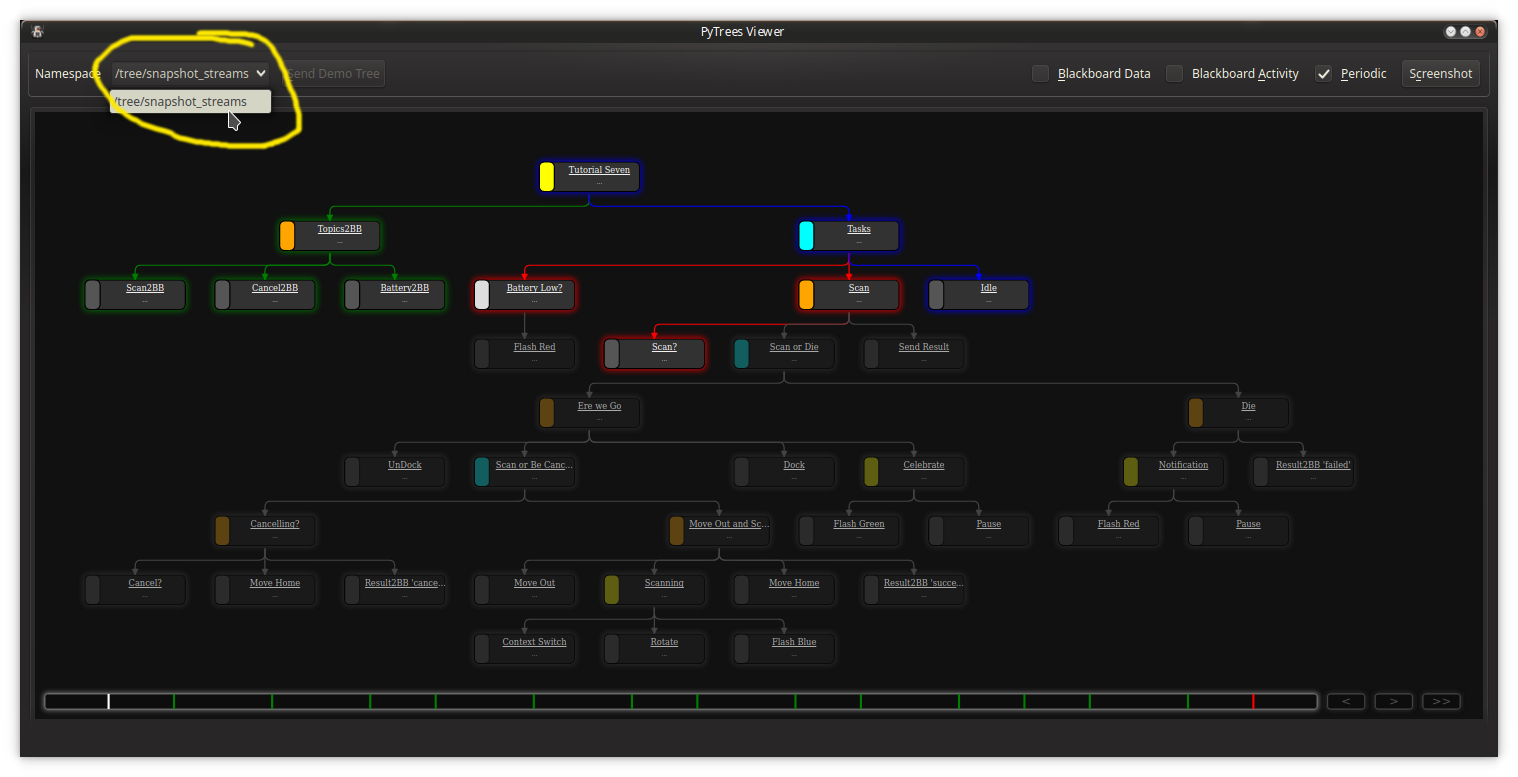
At a minimum, the stream will send updates to the tree graph when the tree changes (i.e. when any one of the behaviours modifies it’s status). Additional configuration of the stream can be managed via the checkboxes in the top right of the window - introspect on the blackboard and/or request more frequent updates (useful when tracking blackboard changes).
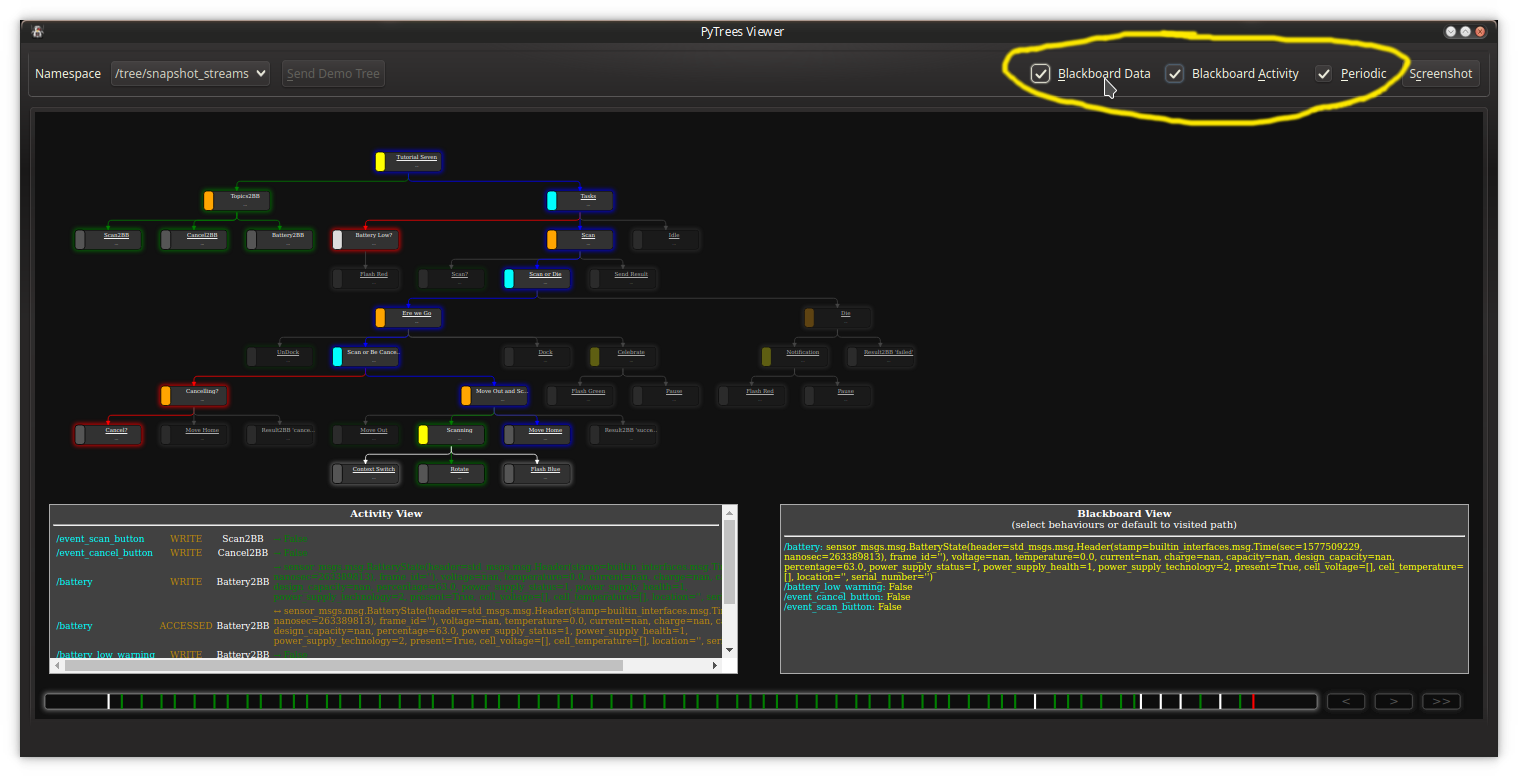
If you have a large tree, collapse sections of it. This is useful in tandem with the screenshot capability when you wish to highlight an area of interest to communicate a design problem or report a bug.
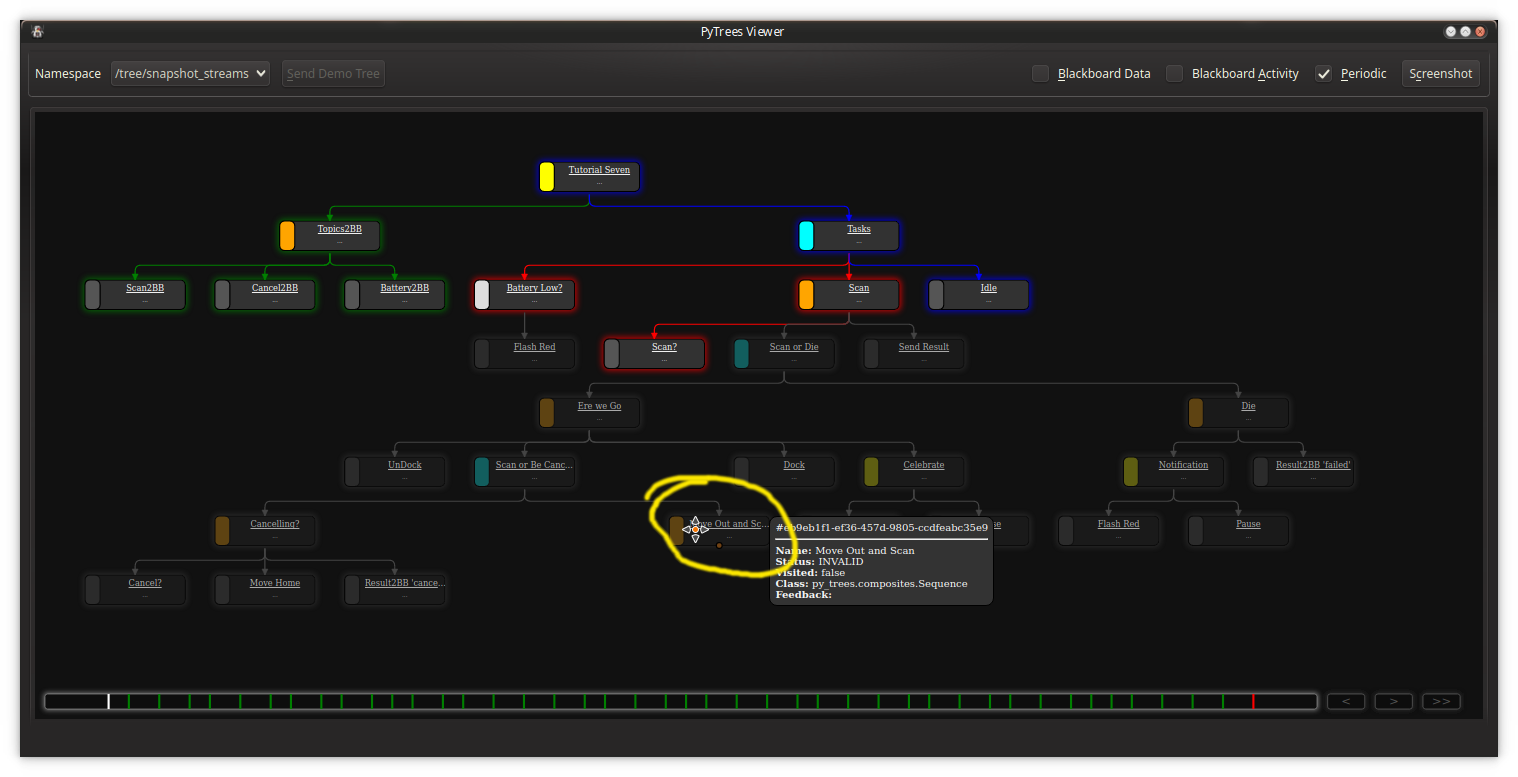
In the same vein, filter the blackboard to those keys expicitly associated (used) by manually selected behaviours.
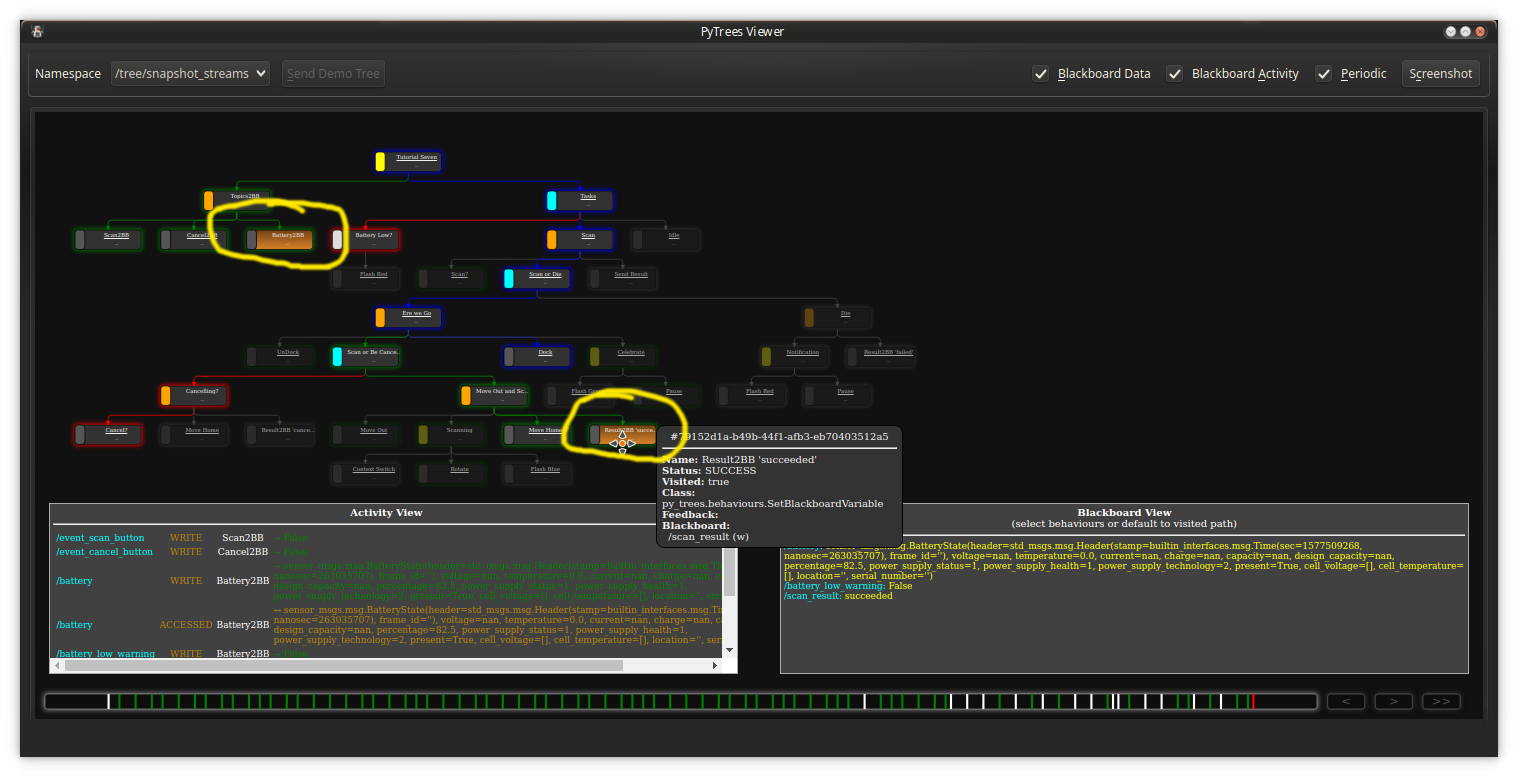
Problems debugging a catastrophe and the final state of the tree doesn’t uncover the root cause, merely the mayhem that resulted? This is a very common situation - use the timeline! Rewind to a previous state and time travel. Note: the stream configuration only applies to future messages - you can’t change the past! If you are concerned about being able to debug affectively, make sure you have at least the ‘Blackboard Data’ and ‘Periodic’ checkboxes enabled so that time travelling along the timeline has sufficient data for analysis.
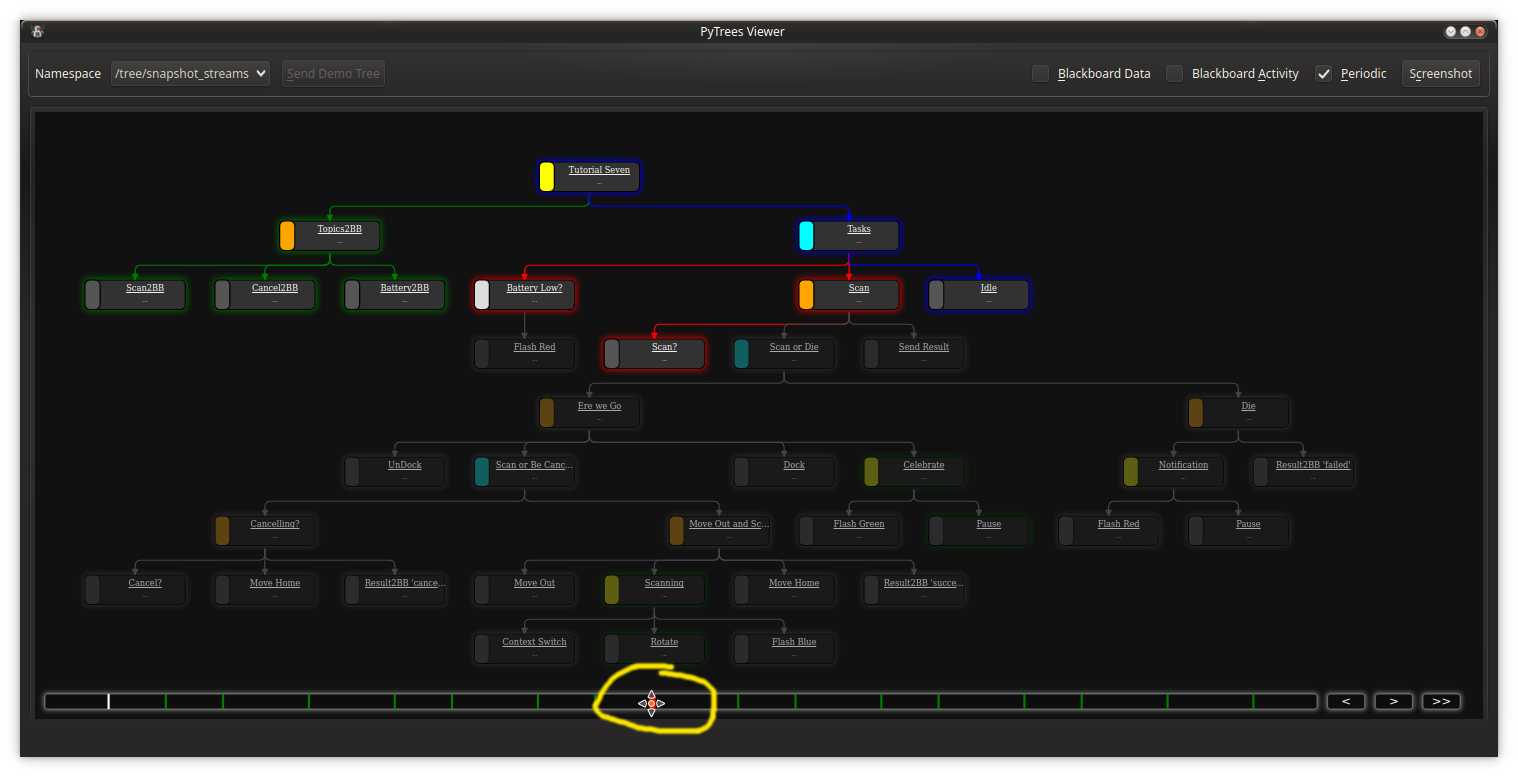
Travelling along the timeline is possible even while online. Simply hit the ‘Resume’ button to resume visualisation of the live feed.
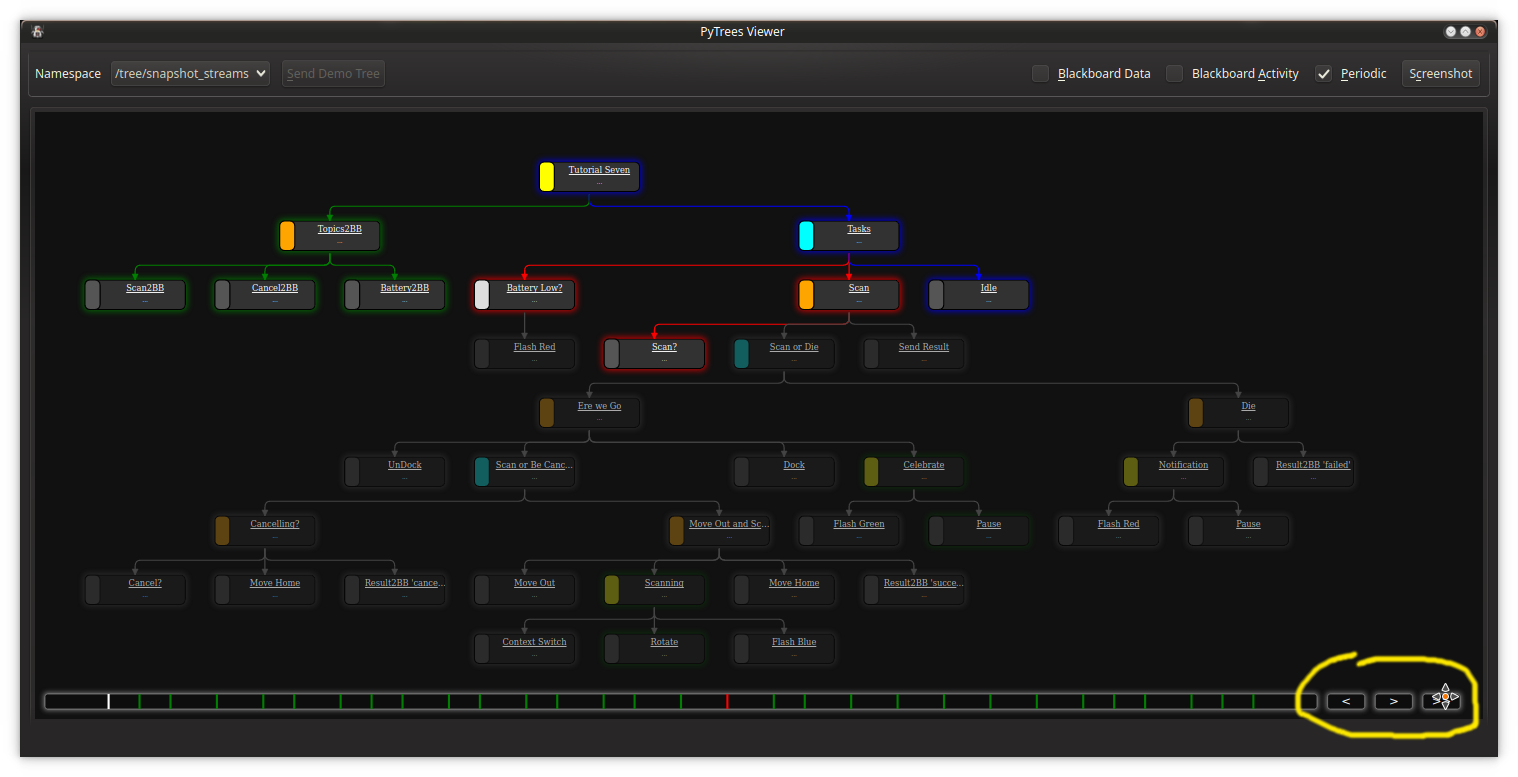
Modding
The underlying py_trees_js library lends itself to being used in various ways. This
application can be used as a baseline reference (since it utilises the underlying
py_trees_js library fully) for modifications to suit your own use case. Open an
issue if you have
questions and/or would like assistance.
1) Visualisation for a behaviour trees implementation that is not py_trees.
Replicate the hybrid qt-js application here and replace backend.py. The data structure eventually passed to the js library is a json dictionary that only makes use of the most fundamental properties of behaviour trees (e.g. tree graph structure, behaviour status) and consequently, it should be a matter of merely wiring connections and converting data.
2) Visualisation for a different middleware architecture
This follows much the same procedure as for the first use case - replace backend.py. For example, a ROS1 viewer for py_trees could be built in this manner.
3) Visualisation in a mobile device
Since the core of the application is a js library, the bridge to moving from a
developer friendly application to a lightweight web application, or a widget embedded
in another web application is much smaller. Again it is merely a matter of
generating the required input channel and data conversions. Refer to the
py_trees_js README for more
details.
Changelog
0.2.5 (2025-01-13)
- [readme] Small tweaks (#41)
- [infra] Fix repo URL in package.xml
- [infra] Add dummy test to make buildfarm happy (#40)
- Contributors: Sebastian Castro
0.2.4 (2025-01-11)
- [code] Fixed Namespace switching error (#35)
- [code] Update deprecated QoS settings (#34)
- [infra] resolve chrome 80+ incompatibility (#32)
- Contributors: Daniel Stonier, Sebastian Castro, J Keshav Bhupathy Vignesh
0.2.3 (2020-02-24)
- [backend] capture paralell policy details
0.2.2 (2019-12-30)
- [docs] using ros2 launch, not ros2 run for the tutorials
0.2.1 (2019-12-28)
- [docs] usage instructions
0.2.0 (2019-12-28)
0.1.4 (2019-10-26)
- [infra] update to make use of usability / performance improvements
in
py_trees_js v0.5.1
0.1.3 (2019-08-29)
- [html] disable scrollbars, #24
- [html] use new 0.5.0 window resizing api
from py_trees_js
0.1.2 (2019-08-14)
- [backend] bugfix dependency on
py_trees_js, notpy_trees_ros_js
0.1.1 (2019-08-13)
- [backend] bugfix colour mixup between decorators and behaviours
0.1.0 (2019-08-13)
0.0.0 (2019-08-09)
- Initial package structure
Wiki Tutorials
Package Dependencies
System Dependencies
Dependant Packages
Launch files
Messages
Services
Plugins
Recent questions tagged py_trees_ros_viewer at Robotics Stack Exchange

|
py_trees_ros_viewer package from py_trees_ros_viewer repopy_trees_ros_viewer |
|
|
Package Summary
| Tags | No category tags. |
| Version | 0.2.5 |
| License | BSD |
| Build type | AMENT_PYTHON |
| Use | RECOMMENDED |
Repository Summary
| Checkout URI | https://github.com/splintered-reality/py_trees_ros_viewer.git |
| VCS Type | git |
| VCS Version | devel |
| Last Updated | 2025-01-14 |
| Dev Status | MAINTAINED |
| CI status | No Continuous Integration |
| Released | RELEASED |
| Tags | No category tags. |
| Contributing |
Help Wanted (0)
Good First Issues (0) Pull Requests to Review (0) |
Package Description
Additional Links
Maintainers
- Daniel Stonier
- Sebastian Castro
Authors
- Daniel Stonier
PyTrees ROS Viewer
[About] [Features] [Quickstart] [Usage] [Modding]
About
A Qt-JS application for visualisation of behaviour trees in a ROS 2 ecosystem. This implementation serves as the GUI visualisation tool for PyTrees ROS.
Features
- Tree Visualisation
- Collapsible Subtrees
- Zoom and Scale Contents to Fit
- Timeline Rewind & Resume
- Blackboard View
- Activity View
Quickstart
sudo apt install ros-<rosdistro>-py-trees-ros-tutorials
sudo apt install ros-<rosdistro>-py-trees-ros-viewer
# In a first shell
py-trees-tree-viewer
# In a second shell
ros2 launch py_trees_ros_tutorials tutorial_eight_dynamic_application_laoding_launch.py
# Click 'Scan' on the qt robot dashboard interface
# Wear a colander, I am too.
Usage
Until a snapshot stream is discovered or selected, you’ll land at the splash screen which enumerates the interactive options available.

The viewer will continuously scan for and update the namespace drop-down with a list of py_tree instances (specifically, the namespace of their snapshot stream services). If not yet connected, it will provide the convenience of automatically making a connection to the first instance it discovers. Beyond that, it is possible to switch between streaming services via the drop-down.

At a minimum, the stream will send updates to the tree graph when the tree changes (i.e. when any one of the behaviours modifies it’s status). Additional configuration of the stream can be managed via the checkboxes in the top right of the window - introspect on the blackboard and/or request more frequent updates (useful when tracking blackboard changes).

If you have a large tree, collapse sections of it. This is useful in tandem with the screenshot capability when you wish to highlight an area of interest to communicate a design problem or report a bug.

In the same vein, filter the blackboard to those keys expicitly associated (used) by manually selected behaviours.

Problems debugging a catastrophe and the final state of the tree doesn’t uncover the root cause, merely the mayhem that resulted? This is a very common situation - use the timeline! Rewind to a previous state and time travel. Note: the stream configuration only applies to future messages - you can’t change the past! If you are concerned about being able to debug affectively, make sure you have at least the ‘Blackboard Data’ and ‘Periodic’ checkboxes enabled so that time travelling along the timeline has sufficient data for analysis.

Travelling along the timeline is possible even while online. Simply hit the ‘Resume’ button to resume visualisation of the live feed.

Modding
The underlying py_trees_js library lends itself to being used in various ways. This
application can be used as a baseline reference (since it utilises the underlying
py_trees_js library fully) for modifications to suit your own use case. Open an
issue if you have
questions and/or would like assistance.
1) Visualisation for a behaviour trees implementation that is not py_trees.
Replicate the hybrid qt-js application here and replace backend.py. The data structure eventually passed to the js library is a json dictionary that only makes use of the most fundamental properties of behaviour trees (e.g. tree graph structure, behaviour status) and consequently, it should be a matter of merely wiring connections and converting data.
2) Visualisation for a different middleware architecture
This follows much the same procedure as for the first use case - replace backend.py. For example, a ROS1 viewer for py_trees could be built in this manner.
3) Visualisation in a mobile device
Since the core of the application is a js library, the bridge to moving from a
developer friendly application to a lightweight web application, or a widget embedded
in another web application is much smaller. Again it is merely a matter of
generating the required input channel and data conversions. Refer to the
py_trees_js README for more
details.
Changelog
0.2.5 (2025-01-13)
- [readme] Small tweaks (#41)
- [infra] Fix repo URL in package.xml
- [infra] Add dummy test to make buildfarm happy (#40)
- Contributors: Sebastian Castro
0.2.4 (2025-01-11)
- [code] Fixed Namespace switching error (#35)
- [code] Update deprecated QoS settings (#34)
- [infra] resolve chrome 80+ incompatibility (#32)
- Contributors: Daniel Stonier, Sebastian Castro, J Keshav Bhupathy Vignesh
0.2.3 (2020-02-24)
- [backend] capture paralell policy details
0.2.2 (2019-12-30)
- [docs] using ros2 launch, not ros2 run for the tutorials
0.2.1 (2019-12-28)
- [docs] usage instructions
0.2.0 (2019-12-28)
0.1.4 (2019-10-26)
- [infra] update to make use of usability / performance improvements
in
py_trees_js v0.5.1
0.1.3 (2019-08-29)
- [html] disable scrollbars, #24
- [html] use new 0.5.0 window resizing api
from py_trees_js
0.1.2 (2019-08-14)
- [backend] bugfix dependency on
py_trees_js, notpy_trees_ros_js
0.1.1 (2019-08-13)
- [backend] bugfix colour mixup between decorators and behaviours
0.1.0 (2019-08-13)
0.0.0 (2019-08-09)
- Initial package structure
Wiki Tutorials
Package Dependencies
System Dependencies
Dependant Packages
Launch files
Messages
Services
Plugins
Recent questions tagged py_trees_ros_viewer at Robotics Stack Exchange

|
py_trees_ros_viewer package from py_trees_ros_viewer repopy_trees_ros_viewer |
|
|
Package Summary
| Tags | No category tags. |
| Version | 0.2.5 |
| License | BSD |
| Build type | AMENT_PYTHON |
| Use | RECOMMENDED |
Repository Summary
| Checkout URI | https://github.com/splintered-reality/py_trees_ros_viewer.git |
| VCS Type | git |
| VCS Version | devel |
| Last Updated | 2025-01-14 |
| Dev Status | MAINTAINED |
| CI status | No Continuous Integration |
| Released | RELEASED |
| Tags | No category tags. |
| Contributing |
Help Wanted (0)
Good First Issues (0) Pull Requests to Review (0) |
Package Description
Additional Links
Maintainers
- Daniel Stonier
- Sebastian Castro
Authors
- Daniel Stonier
PyTrees ROS Viewer
[About] [Features] [Quickstart] [Usage] [Modding]
About
A Qt-JS application for visualisation of behaviour trees in a ROS 2 ecosystem. This implementation serves as the GUI visualisation tool for PyTrees ROS.
Features
- Tree Visualisation
- Collapsible Subtrees
- Zoom and Scale Contents to Fit
- Timeline Rewind & Resume
- Blackboard View
- Activity View
Quickstart
sudo apt install ros-<rosdistro>-py-trees-ros-tutorials
sudo apt install ros-<rosdistro>-py-trees-ros-viewer
# In a first shell
py-trees-tree-viewer
# In a second shell
ros2 launch py_trees_ros_tutorials tutorial_eight_dynamic_application_laoding_launch.py
# Click 'Scan' on the qt robot dashboard interface
# Wear a colander, I am too.
Usage
Until a snapshot stream is discovered or selected, you’ll land at the splash screen which enumerates the interactive options available.

The viewer will continuously scan for and update the namespace drop-down with a list of py_tree instances (specifically, the namespace of their snapshot stream services). If not yet connected, it will provide the convenience of automatically making a connection to the first instance it discovers. Beyond that, it is possible to switch between streaming services via the drop-down.

At a minimum, the stream will send updates to the tree graph when the tree changes (i.e. when any one of the behaviours modifies it’s status). Additional configuration of the stream can be managed via the checkboxes in the top right of the window - introspect on the blackboard and/or request more frequent updates (useful when tracking blackboard changes).

If you have a large tree, collapse sections of it. This is useful in tandem with the screenshot capability when you wish to highlight an area of interest to communicate a design problem or report a bug.

In the same vein, filter the blackboard to those keys expicitly associated (used) by manually selected behaviours.

Problems debugging a catastrophe and the final state of the tree doesn’t uncover the root cause, merely the mayhem that resulted? This is a very common situation - use the timeline! Rewind to a previous state and time travel. Note: the stream configuration only applies to future messages - you can’t change the past! If you are concerned about being able to debug affectively, make sure you have at least the ‘Blackboard Data’ and ‘Periodic’ checkboxes enabled so that time travelling along the timeline has sufficient data for analysis.

Travelling along the timeline is possible even while online. Simply hit the ‘Resume’ button to resume visualisation of the live feed.

Modding
The underlying py_trees_js library lends itself to being used in various ways. This
application can be used as a baseline reference (since it utilises the underlying
py_trees_js library fully) for modifications to suit your own use case. Open an
issue if you have
questions and/or would like assistance.
1) Visualisation for a behaviour trees implementation that is not py_trees.
Replicate the hybrid qt-js application here and replace backend.py. The data structure eventually passed to the js library is a json dictionary that only makes use of the most fundamental properties of behaviour trees (e.g. tree graph structure, behaviour status) and consequently, it should be a matter of merely wiring connections and converting data.
2) Visualisation for a different middleware architecture
This follows much the same procedure as for the first use case - replace backend.py. For example, a ROS1 viewer for py_trees could be built in this manner.
3) Visualisation in a mobile device
Since the core of the application is a js library, the bridge to moving from a
developer friendly application to a lightweight web application, or a widget embedded
in another web application is much smaller. Again it is merely a matter of
generating the required input channel and data conversions. Refer to the
py_trees_js README for more
details.
Changelog
0.2.5 (2025-01-13)
- [readme] Small tweaks (#41)
- [infra] Fix repo URL in package.xml
- [infra] Add dummy test to make buildfarm happy (#40)
- Contributors: Sebastian Castro
0.2.4 (2025-01-11)
- [code] Fixed Namespace switching error (#35)
- [code] Update deprecated QoS settings (#34)
- [infra] resolve chrome 80+ incompatibility (#32)
- Contributors: Daniel Stonier, Sebastian Castro, J Keshav Bhupathy Vignesh
0.2.3 (2020-02-24)
- [backend] capture paralell policy details
0.2.2 (2019-12-30)
- [docs] using ros2 launch, not ros2 run for the tutorials
0.2.1 (2019-12-28)
- [docs] usage instructions
0.2.0 (2019-12-28)
0.1.4 (2019-10-26)
- [infra] update to make use of usability / performance improvements
in
py_trees_js v0.5.1
0.1.3 (2019-08-29)
- [html] disable scrollbars, #24
- [html] use new 0.5.0 window resizing api
from py_trees_js
0.1.2 (2019-08-14)
- [backend] bugfix dependency on
py_trees_js, notpy_trees_ros_js
0.1.1 (2019-08-13)
- [backend] bugfix colour mixup between decorators and behaviours
0.1.0 (2019-08-13)
0.0.0 (2019-08-09)
- Initial package structure
Wiki Tutorials
Package Dependencies
System Dependencies
Dependant Packages
Launch files
Messages
Services
Plugins
Recent questions tagged py_trees_ros_viewer at Robotics Stack Exchange

|
py_trees_ros_viewer package from py_trees_ros_viewer repopy_trees_ros_viewer |
|
|
Package Summary
| Tags | No category tags. |
| Version | 0.1.4 |
| License | BSD |
| Build type | AMENT_PYTHON |
| Use | RECOMMENDED |
Repository Summary
| Checkout URI | https://github.com/splintered-reality/py_trees_ros_viewer.git |
| VCS Type | git |
| VCS Version | release/0.1.x |
| Last Updated | 2019-10-29 |
| Dev Status | MAINTAINED |
| CI status | No Continuous Integration |
| Released | RELEASED |
| Tags | No category tags. |
| Contributing |
Help Wanted (0)
Good First Issues (0) Pull Requests to Review (0) |
Package Description
Additional Links
Maintainers
- Daniel Stonier
Authors
- Daniel Stonier
PyTrees Ros Viewer
A Qt-JS application for visualisation of executing/log-replayed behaviour trees in a ROS2 ecosystem.
- Render Behaviour Tree Streams
- Collapsible Subtrees
- Zoom and Scale Contents to Fit
- Timeline Rewind & Resume
Quickstart instructions:
# Only released in rosdistro's dashing and later
sudo apt install ros-<rosdistro>-py-trees-ros-tutorials
sudo apt install ros-<rosdistro>-py-trees-ros-viewer
# In a first shell
py-trees-tree-viewer
# In a second shell
ros2 run py_trees_ros_tutorials tutorial-eight-dynamic-application-loading
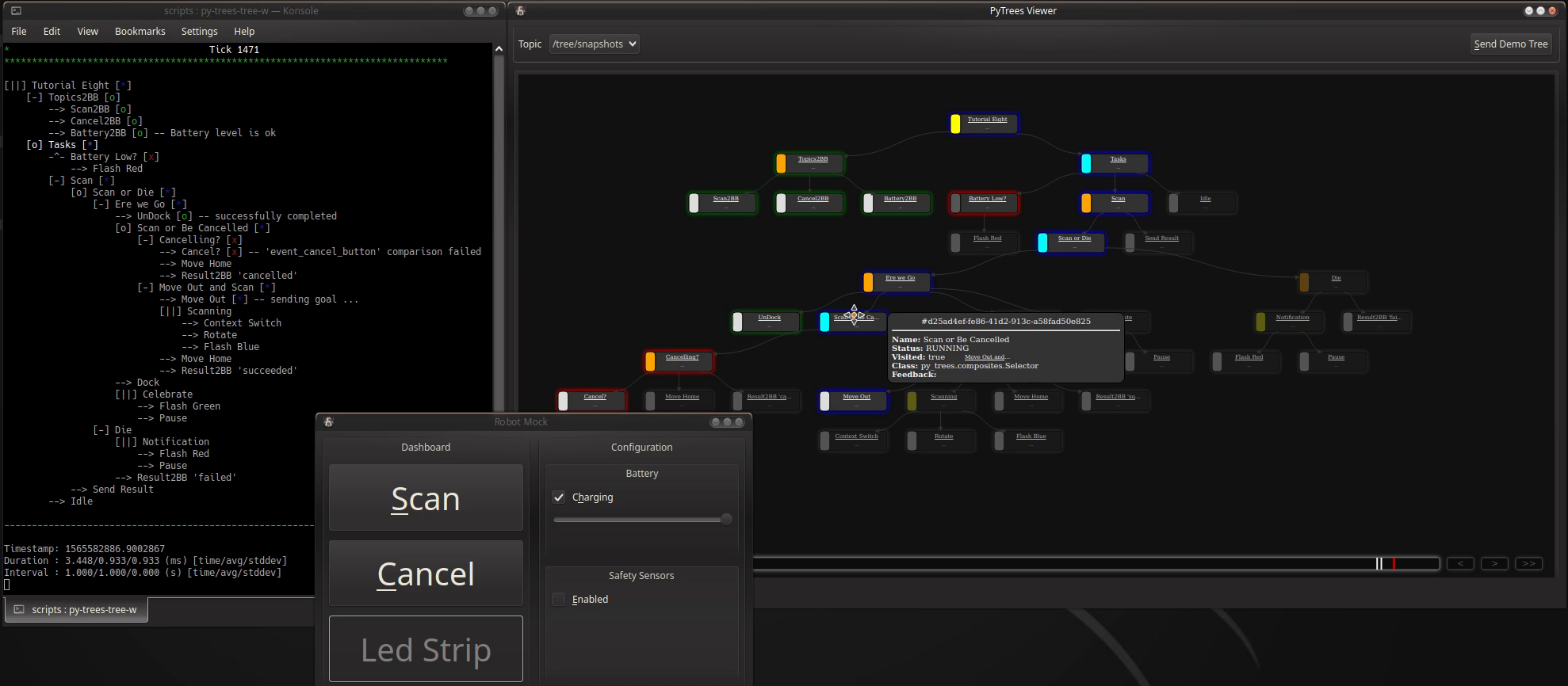
Changelog
Forthcoming
0.1.4 (2019-10-26)
- [infra] update to make use of usability / performance improvements
in
py_trees_js v0.5.1
0.1.3 (2019-08-29)
- [html] disable scrollbars, #24
- [html] use new 0.5.0 window resizing api
from py_trees_js
0.1.2 (2019-08-14)
- [backend] bugfix dependency on
py_trees_js, notpy_trees_ros_js
0.1.1 (2019-08-13)
- [backend] bugfix colour mixup between decorators and behaviours
0.1.0 (2019-08-13)
0.0.0 (2019-08-09)
- Initial package structure
Wiki Tutorials
Package Dependencies
System Dependencies
Dependant Packages
Launch files
Messages
Services
Plugins
Recent questions tagged py_trees_ros_viewer at Robotics Stack Exchange

|
py_trees_ros_viewer package from py_trees_ros_viewer repopy_trees_ros_viewer |
|
|
Package Summary
| Tags | No category tags. |
| Version | 0.1.4 |
| License | BSD |
| Build type | AMENT_PYTHON |
| Use | RECOMMENDED |
Repository Summary
| Checkout URI | https://github.com/splintered-reality/py_trees_ros_viewer.git |
| VCS Type | git |
| VCS Version | release/0.1.x |
| Last Updated | 2019-10-29 |
| Dev Status | MAINTAINED |
| CI status | No Continuous Integration |
| Released | RELEASED |
| Tags | No category tags. |
| Contributing |
Help Wanted (0)
Good First Issues (0) Pull Requests to Review (0) |
Package Description
Additional Links
Maintainers
- Daniel Stonier
Authors
- Daniel Stonier
PyTrees Ros Viewer
A Qt-JS application for visualisation of executing/log-replayed behaviour trees in a ROS2 ecosystem.
- Render Behaviour Tree Streams
- Collapsible Subtrees
- Zoom and Scale Contents to Fit
- Timeline Rewind & Resume
Quickstart instructions:
# Only released in rosdistro's dashing and later
sudo apt install ros-<rosdistro>-py-trees-ros-tutorials
sudo apt install ros-<rosdistro>-py-trees-ros-viewer
# In a first shell
py-trees-tree-viewer
# In a second shell
ros2 run py_trees_ros_tutorials tutorial-eight-dynamic-application-loading

Changelog
Forthcoming
0.1.4 (2019-10-26)
- [infra] update to make use of usability / performance improvements
in
py_trees_js v0.5.1
0.1.3 (2019-08-29)
- [html] disable scrollbars, #24
- [html] use new 0.5.0 window resizing api
from py_trees_js
0.1.2 (2019-08-14)
- [backend] bugfix dependency on
py_trees_js, notpy_trees_ros_js
0.1.1 (2019-08-13)
- [backend] bugfix colour mixup between decorators and behaviours
0.1.0 (2019-08-13)
0.0.0 (2019-08-09)
- Initial package structure
Wiki Tutorials
Package Dependencies
System Dependencies
Dependant Packages
Launch files
Messages
Services
Plugins
Recent questions tagged py_trees_ros_viewer at Robotics Stack Exchange

|
py_trees_ros_viewer package from py_trees_ros_viewer repopy_trees_ros_viewer |
|
|
Package Summary
| Tags | No category tags. |
| Version | 0.2.3 |
| License | BSD |
| Build type | AMENT_PYTHON |
| Use | RECOMMENDED |
Repository Summary
| Checkout URI | https://github.com/splintered-reality/py_trees_ros_viewer.git |
| VCS Type | git |
| VCS Version | release/0.2.x |
| Last Updated | 2020-01-25 |
| Dev Status | MAINTAINED |
| CI status | No Continuous Integration |
| Released | RELEASED |
| Tags | No category tags. |
| Contributing |
Help Wanted (0)
Good First Issues (0) Pull Requests to Review (0) |
Package Description
Additional Links
Maintainers
- Daniel Stonier
Authors
- Daniel Stonier
PyTrees Ros Viewer
[About] [Features] [Quickstart] [Usage] [Modding]
About
A Qt-JS application for visualisation of behaviour trees in a ROS2 ecosystem. This implementation serves as the gui visualisation tool for ROS2 PyTrees.
Features
- Tree Visualisation
- Collapsible Subtrees
- Zoom and Scale Contents to Fit
- Timeline Rewind & Resume
- Blackboard View
- Activity View
Quickstart
sudo apt install ros-<rosdistro>-py-trees-ros-tutorials
sudo apt install ros-<rosdistro>-py-trees-ros-viewer
# In a first shell
py-trees-tree-viewer
# In a second shell
ros2 launch py_trees_ros_tutorials tutorial_eight_dynamic_application_laoding_launch.py
# Click 'Scan' on the qt robot dashboard interface
# Wear a colander, I am too.
Usage
Until a snapshot stream is discovered or selected, you’ll land at the splash screen which enumerates the interactive options available.
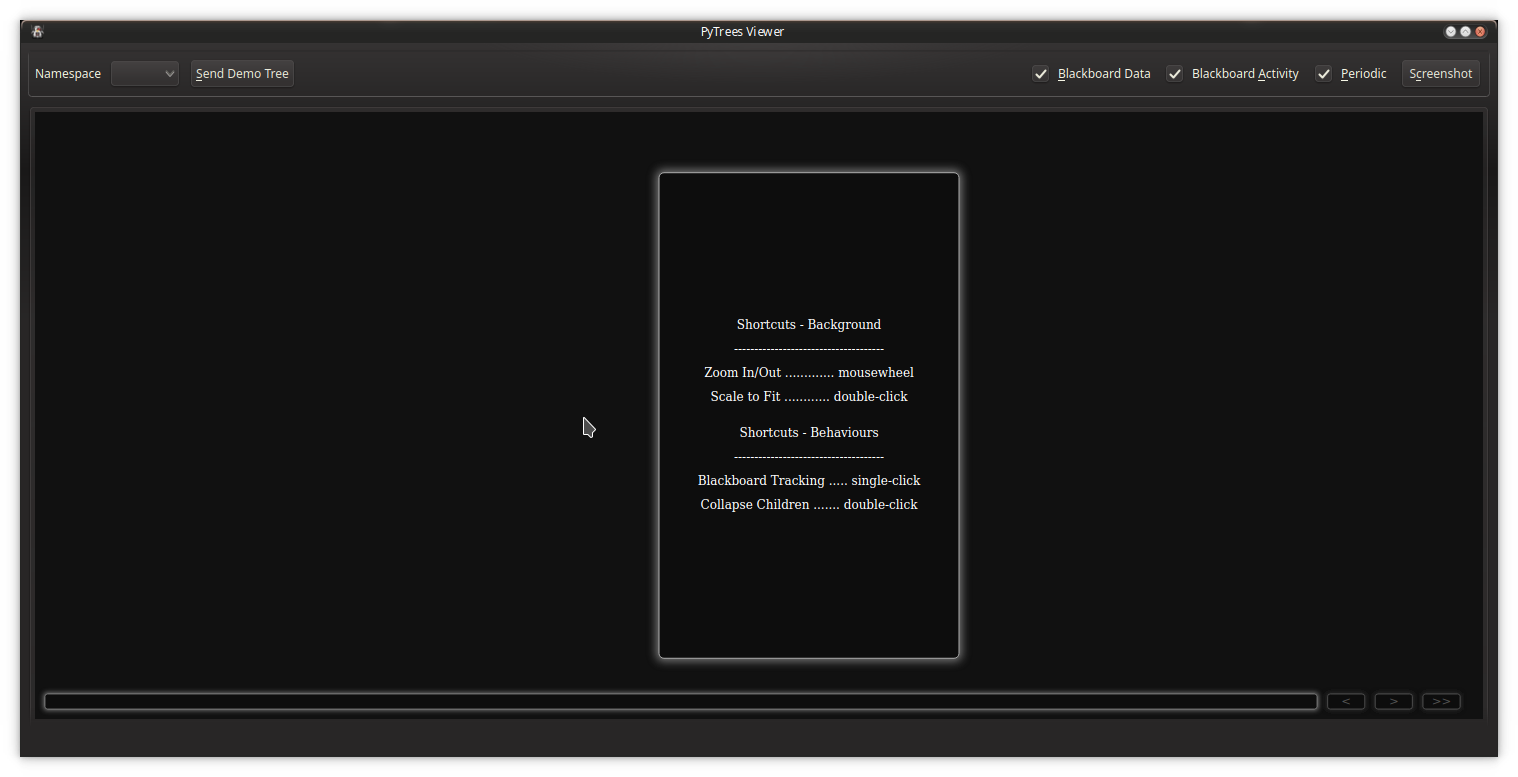
The viewer will continuously scan for and update the namespace drop-down with a list of py_tree instances (specifically, the namespace of their snapshot stream services). If not yet connected, it will provide the convenience of automatically making a connection to the first instance it discovers. Beyond that, it is possible to switch between streaming services via the drop-down.

At a minimum, the stream will send updates to the tree graph when the tree changes (i.e. when any one of the behaviours modifies it’s status). Additional configuration of the stream can be managed via the checkboxes in the top right of the window - introspect on the blackboard and/or request more frequent updates (useful when tracking blackboard changes).

If you have a large tree, collapse sections of it. This is useful in tandem with the screenshot capability when you wish to highlight an area of interest to communicate a design problem or report a bug.

In the same vein, filter the blackboard to those keys expicitly associated (used) by manually selected behaviours.

Problems debugging a catastrophe and the final state of the tree doesn’t uncover the root cause, merely the mayhem that resulted? This is a very common situation - use the timeline! Rewind to a previous state and time travel. Note: the stream configuration only applies to future messages - you can’t change the past! If you are concerned about being able to debug affectively, make sure you have at least the ‘Blackboard Data’ and ‘Periodic’ checkboxes enabled so that time travelling along the timeline has sufficient data for analysis.

Travelling along the timeline is possible even while online. Simply hit the ‘Resume’ button to resume visualisation of the live feed.

Modding
The underlying py_trees_js library lends itself to being used in various ways. This
application can be used as a baseline reference (since it utilises the underlying
py_trees_js library fully) for modifications to suit your own use case. Open an
issue if you have
questions and/or would like assistance.
1) Visualisation for a behaviour trees implementation that is not py_trees.
Replicate the hybrid qt-js application here and replace backend.py. The data structure eventually passed to the js library is a json dictionary that only makes use of the most fundamental properties of behaviour trees (e.g. tree graph structure, behaviour status) and consequently, it should be a matter of merely wiring connections and converting data.
2) Visualisation for a different middleware architecture
This follows much the same procedure as for the first use case - replace backend.py. For example, a ROS1 viewer for py_trees could be built in this manner.
3) Visualisation in a mobile device
Since the core of the application is a js library, the bridge to moving from a
developer friendly application to a lightweight web application, or a widget embedded
in another web application is much smaller. Again it is merely a matter of
generating the required input channel and data conversions. Refer to the
py_trees_js README for more
details.
Changelog
Forthcoming
- ...
0.2.3 (2020-02-24)
- [backend] capture paralell policy details
0.2.2 (2019-12-30)
- [docs] using ros2 launch, not ros2 run for the tutorials
0.2.1 (2019-12-28)
- [docs] usage instructions
0.2.0 (2019-12-28)
0.1.4 (2019-10-26)
- [infra] update to make use of usability / performance improvements
in
py_trees_js v0.5.1
0.1.3 (2019-08-29)
- [html] disable scrollbars, #24
- [html] use new 0.5.0 window resizing api
from py_trees_js
0.1.2 (2019-08-14)
- [backend] bugfix dependency on
py_trees_js, notpy_trees_ros_js
0.1.1 (2019-08-13)
- [backend] bugfix colour mixup between decorators and behaviours
0.1.0 (2019-08-13)
0.0.0 (2019-08-09)
- Initial package structure